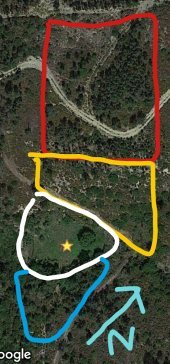I really don't know where to put this question.
What food plants shall I put under my Big Leaf Maple (Acer macrophyllum) tree?
I have a big leaf maple in the bottom, North West corner of the old chicken run that I'm converting to terraced gardening. The tree is the corner post in the fence, so the area I'm looking at is a 90 degree wedge that spread out from the tree. It's a moderate to large size for a Big Leaf Maple, and produces copious amounts of mulch each year. Because the chickens were there for a few years, there is very little growing under the tree. Right now we have miner's lettuce, annoying white flower weed, sorrel, dandelions, chickweed, a few thistles, and buttercup. I'm guessing fairly acidic soil,
This area will receive no inputs from me. No water, no manure, no attention, no tilling/digging except to harvest. It may get a light dusting of wood ash and borax at the start of this project just to get the soil more friendly for clover. This is a low interaction space that is close to the road and far enough from the house I can't be bothered to go there daily. What it will receive is pruning of over aggressive plants, harvesting, and weeding. The weeds go to the hens that are at the top of the now terraced ridge (ridge runs more or less north south here).
I'm leaving the weeds I like to eat and pulling up the buttercup, thistles, and annoying white flowered weeds (shepherd's purse - because I really don't like it even though it's edible, and another one that looks suspiciously like miniature winter cress). As I pull up the weeds, I want to sprinkle a pinch of seeds in the disturbed soil.
This is our rain star.

As you can see, winters are wet and summers are dry. July has an average of zero rainfall. We do however, get a heavy morning dew most summer days, and the area under this maple is often moisture than the surrounding soil. Of course, that's relative. The surrounding soil is bone dry, whereas in the summer, the soil under the tree is sometimes very slightly damp.
It's full sun most of the winter (or it would be if it wasn't almost always cloudy), and part sun in the summer.
So what types of food, healing and dye plants would be worth growing here?












